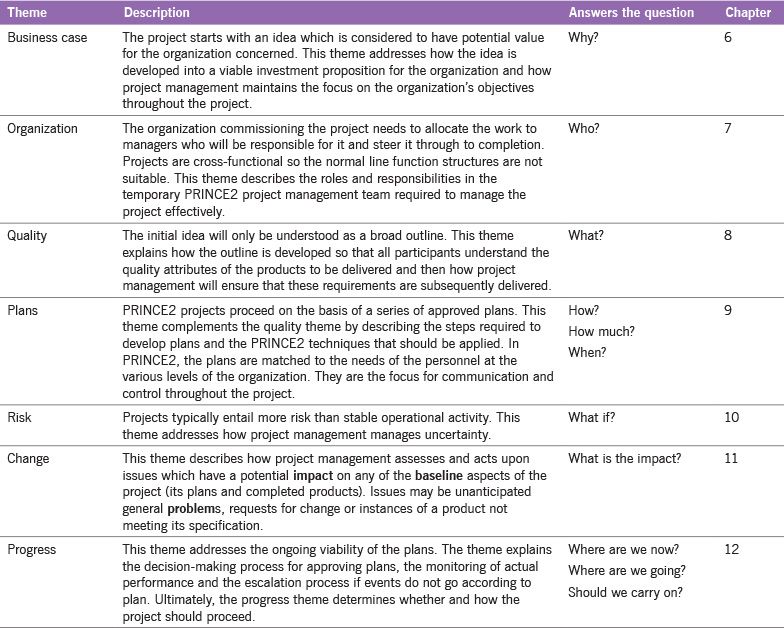5
Introduction to PRINCE2 themes
This chapter covers:
•what themes are and why they matter
•the seven PRINCE2 themes
•basic concepts about tailoring the themes
•the structure of the themes chapters
5 Introduction to PRINCE2 themes
The PRINCE2 themes describe aspects of project management that must be addressed continually as the project progresses through its lifecycle. For example, the business justification for the project will need to be updated and revalidated throughout the project lifecycle, change will take place and risks will need to be managed.
However, the strength of PRINCE2 is the way in which the seven themes are integrated, and this is achieved because of the specific PRINCE2 treatment of each theme (i.e. they are carefully designed to link together effectively).
The PRINCE2 processes (see Chapters 13 to 20) address the chronological flow of the project, with actions relating to different themes mixed together. Here, in the theme chapters, the logical thread that runs through each theme is highlighted and more detailed guidance is provided in order to amplify the process activities. Table 5.1 lists the seven PRINCE2 themes and the chapters in which they are described in more detail.
How the themes are applied can be influenced by tailoring. This may range from being rigid and prescriptive through to allowing the project management team a large degree of freedom as to how they implement each theme.
All seven themes must be applied in a project but they should be tailored according to the risk, scale, nature, complexity or simplicity of the project concerned, always ensuring that any minimum requirements specified in a theme are satisfied.
A tailored PRINCE2 theme should reflect any tailoring of the processes and terminology. Tailoring a theme does not necessarily mean rewriting a PRINCE2 theme itself. In most cases, the themes are implemented through the project’s risk, quality, change control and communication management approaches. These should contain procedures regarding how the themes are implemented in practice for that particular project. The level of control required will influence the degree of formality and frequency of monitoring, reviewing and reporting. When applying the themes, take account of risk and any relevant external factors, such as corporate, portfolio, programme and customer policies and standards, and capture them in the project’s management approaches, as shown in Figure 4.1.
Many of the themes imply that procedures may need to be developed: PRINCE2 does not prescribe how these should be documented or published. They can range from being a simple set of activities to a fully developed procedure with a flow chart.
PRINCE2 provides a table of responsibilities relating to each theme; these may be reassigned provided they do not introduce any conflict of interest, particularly between the roles associated with directing a project, as opposed to managing a project.
Each theme in this manual contains suggestions for different tailoring options for implementing the theme in practice, together with ideas on how to deal with some common situations.

Key message
Tailoring allows the PRINCE2 themes to be adapted to create appropriate procedures and controls, provided that:
•the PRINCE2 principles are upheld
•the minimum requirements in each theme are satisfied
•the purpose of each theme is not compromised.

Tip
The processes, procedures and controls through which themes are implemented can become overly complex and prescriptive. This often creates an unnecessary burden on projects and seldom provides greater control.
It is usually better to keep processes and procedures as simple as possible and ensure the project management team really knows how to use them. The more knowledgeable the team, the lighter the processes, procedures and control can be. It is better to coach people in using a process or procedure than to keep adding more detail in the hope they will understand it better.
5.2 Format of the theme chapters
Each theme chapter is structured as follows:
•The theme Why the theme is important to the successful delivery of a project and the core concepts necessary to understand PRINCE2’s requirements for the theme.
•PRINCE2’s requirements for the theme What is required, as a minimum, to be following PRINCE2.
•Guidance for the effective use of the theme How to practically apply the theme to different organizations, environments and delivery approaches.
•Techniques Techniques that can be used for the theme.

